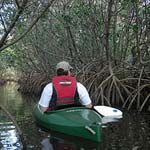 You can paddle however is most comfortable for you, but efficiency is the name of the game...
You can paddle however is most comfortable for you, but efficiency is the name of the game...
Kayaking is supposed to be fun. If done incorrectly, though, you can seriously aggravate the muscles in your back, shoulders and chest. Before we get into kayaking techniques, lets speak first about posture. The most important thing you can do to ensure your kayaking adventure is physically enjoyable is to maintain good posture. If your kayak has a seat back (and most sit-ons do), make sure it is firm and supports your weight. Make all the necessary adjustments before you leave land, as adjusting seat straps is increasingly difficult when you are aleady sitting in the kayak.
For maximum efficiency, you should place your hands on the paddle a little wider than shoulder-width apart. The wider your hands are, the more power you can get per stroke, but place them too far apart, and you will begin to lose efficiency. Hold the paddle firmly, but don't squeeze too hard, or your hands will tire and blister.
